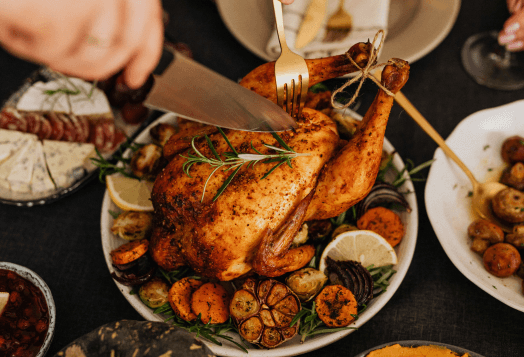With over 9,900 monthly searches for ‘what is keto diet’, it’s clear people are curious, and for good reason. From weight loss to steady energy, keto’s got some real perks. If you're thinking of giving it a shot, this beginner-friendly guide is your perfect starting point.
How the Keto Diet Works and Why It’s a Game Changer
The keto diet—short for ketogenic—is all about switching your body’s main fuel source. Instead of relying on carbs for energy, you train your body to burn fat. This shift puts you into a state called ketosis, where your body turns fat into ketones, a clean and steady energy source for both brain and body.
So, what does that look like on your plate?
Carbs stay under 50g per day
Fats make up about 70–75% of what you eat
Protein stays moderate at around 20–25%
In simple terms: fewer carbs, more healthy fats, and just enough protein. Once you hit ketosis, your body becomes a fat-burning machine, perfect if you’re aiming for sustainable weight loss, better focus, or balanced energy throughout the day.
Why Choose Keto
Keto isn’t just another diet; it’s a powerful metabolic reset. If you’re someone who’s tried dieting before and felt stuck, always hungry, always tired, keto can feel like a turning point. Instead of asking you to eat less and fight cravings, it changes the equation: fat becomes fuel, and meals become satisfying again.
Many people find it easier to lose weight on keto because they’re not battling constant hunger or giving in to sugar cravings. The focus on full, rich meals keeps you satisfied, while your body quietly does the work of burning fat. It’s not just about looking different, it’s about feeling more in control, more energised, and finally making progress that lasts.
Is the Keto Diet Only for Weight Loss

Not at all. While weight loss is one of the most common reasons people try keto, it offers several other health and lifestyle benefits that make it worth considering, even if the scale isn’t your primary concern.
Here’s how keto helps beyond losing weight:
Better Blood Sugar Control
Keto may help regulate insulin and blood sugar levels, which can support people managing type 2 diabetes, insulin resistance, or PCOS.Steady Energy and Mental Focus
By cutting out sugar highs and crashes, ketones provide a more consistent energy source, great for professionals, students, and anyone who needs to stay sharp throughout the day.Appetite and Craving Management
The high-fat, moderate-protein structure of keto helps reduce hunger and keeps you feeling satisfied, making it easier to avoid constant snacking or emotional eating.Endurance and Performance
Some athletes and active individuals turn to keto to improve fat adaptation, enhance endurance, and reduce post-workout recovery time.Metabolic and Brain Health
Early research also suggests keto may support cognitive health and reduce inflammation, making it a promising option for people looking to improve overall metabolic wellness.
So, the keto diet for beginners isn’t just for losing weight; it’s about gaining better control over your body, your energy, and how you feel every day.
Start Strong with a Keto Diet Plan That Works for Beginners
Starting strong makes all the difference. This 2-day keto diet plan for beginners gives you tasty, practical ideas whether you're vegetarian or non-veg.
Day 1 – The Fat-Fuelled Kickstart
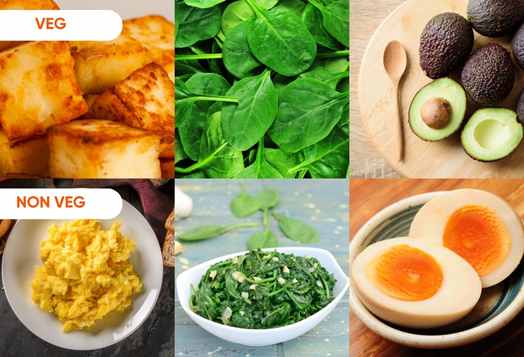
Breakfast
Veg Option: Scrambled paneer cooked in ghee with spinach and a side of avocado
Non-Veg Option: Scrambled eggs in butter with sautéed spinach and a boiled egg on the side
Why this works: Paneer and eggs are great protein sources. Spinach adds fibre and avocado gives you that creamy, healthy fat.
Lunch
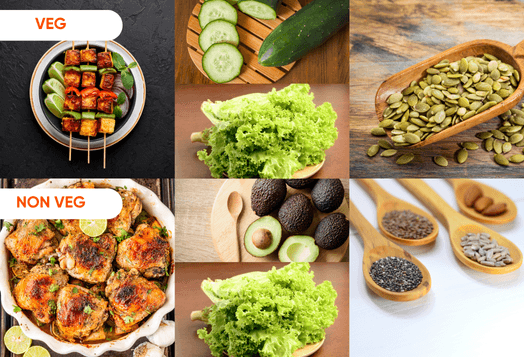
Veg Option: Grilled paneer salad with olive oil, cucumber, lettuce, and pumpkin seeds
Non-Veg Option: Grilled chicken thigh salad with olive oil, lettuce, avocado, and seeds
Tip: Add olives or feta for flavour and healthy fats.
Dinner

Veg Option: Stir-fried tofu or paneer with bell peppers and zucchini in coconut oil
Non-Veg Option: Grilled fish or chicken with sautéed green beans and bell peppers
Tip: Customise with herbs and a pinch of pink salt for taste.
Snacks

A handful of almonds or walnuts, part of healthy foods to eat every day
Cheese cubes or 1 boiled egg
Unsweetened peanut butter with celery sticks
Tip: Keep snack portions small—nuts are healthy but calorie-dense.
Day 2 – Simple, Savoury, and Satisfying
Breakfast
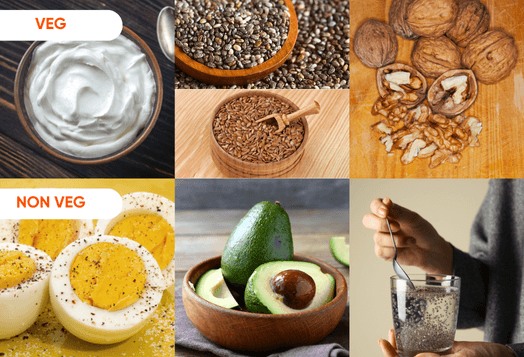
Veg Option: Full-fat Greek yoghurt with chia seeds, flax seeds, and crushed walnuts
Non-Veg Option: 2 boiled eggs with avocado slices and a sprinkle of chia seeds
Tip: Choose unsweetened yoghurt with at least 5g of fat and less than 5g of carbs per serving.
Lunch
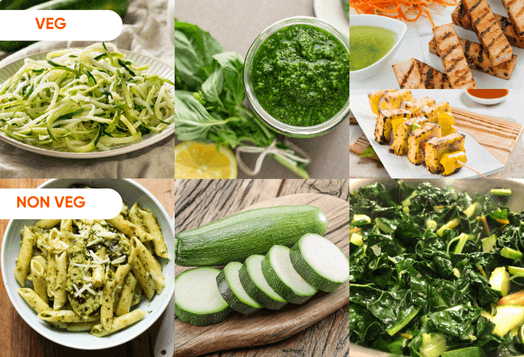
- Veg Option: Zucchini noodles tossed in homemade basil pesto with grilled tofu or paneer
- Non-Veg Option: Chicken pesto bowl with zucchini or sautéed spinach
Tip: Homemade pesto = basil + garlic + olive oil + nuts (skip store-bought with sugar).
Dinner
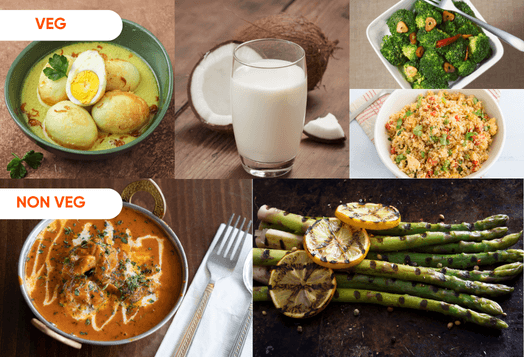
Veg Option: Egg curry with coconut milk and sautéed broccoli or cauliflower rice
Non-Veg Option: Butter chicken (no cream, use butter and spices) with grilled asparagus
Tip: Coconut milk adds richness and fat. Cauliflower rice makes a great low-carb base.
Snacks
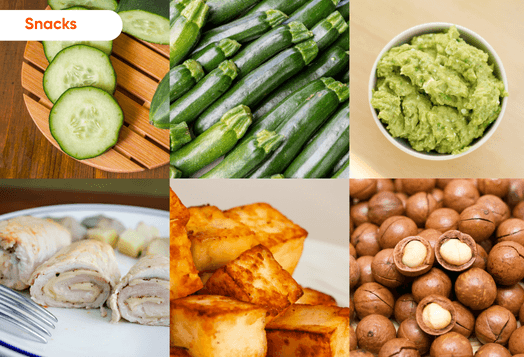
Cucumber or zucchini sticks with guacamole
Cheese roll-ups or paneer cubes with salt and pepper
A few macadamia nuts or almonds
Whether you’re vegetarian, non-vegetarian, or somewhere in between, keto can be tailored to your lifestyle. The trick is balancing your fat and protein intake while keeping carbs low, ideally below 50g per day.
Also, don’t worry if you don’t hit the perfect ratio from Day 1. Your body takes time to adapt to ketosis. What matters is consistency, hydration, and knowing what works best for you.
Common Beginner Mistakes and How to Avoid Them
Starting keto? Great. But don’t let these rookie mistakes trip you up:
Skipping Electrolytes
Ketosis flushes out sodium, potassium, and magnesium, leading to fatigue, headaches, and the dreaded keto flu.
Fix it: Add salt to meals, eat avocados and spinach, and consider magnesium supplements.
Eating Too Few Calories
Cutting carbs doesn’t mean cutting food. Undereating slows your metabolism and drains your energy.
Fix it: Eat enough healthy fats like ghee, nuts, and coconut oil. Track your intake if needed.
Too Much Protein
More isn’t always better. Excess protein can sneakily turn into glucose, pushing you out of ketosis.
Fix it: Keep protein moderate. Focus on fat for fuel.
No Meal Prep
No plan? That’s a plan to fail, especially when considering if fruit juice is good for health. Unplanned meals often mean hidden carbs and poor food choices.
Fix it: Prep in batches. Keep keto-friendly snacks handy like boiled eggs, cheese, and nuts.
Keto-Friendly Grocery List You’ll Actually Use
Confused about what belongs in your keto cart? Don’t worry, we’ve got you. This list breaks it down by category, so you can shop smart and stay on track.
Healthy Fats -Your Main Fuel Source
Fats are the cornerstone of a keto diet. Prioritise high-quality, unprocessed fats that fuel your body and keep you full.
Avocados – Packed with fibre, potassium, and healthy fats
Olive oil – Ideal for dressings and low-heat cooking
Ghee & butter – Great for cooking and flavour
Coconut oil – Boosts ketone production and adds a hint of sweetness
Tip: Cook with fats, drizzle them on meals, and don’t skimp; fat is your primary energy source here.
Moderate Protein Sources
Keto isn’t high-protein; it’s moderate protein. Choose whole, natural sources without added sugars.
Eggs – Versatile, affordable, and nutrient-rich
Paneer & tofu – Great vegetarian options
Chicken & salmon – Lean yet satisfying
Greek yoghurt (unsweetened) – High in protein and low in carbs
Tip: Stick to clean proteins and watch for hidden carbs in marinades or sauces.
Low-Carb Veggies (Fibre + Nutrients Without the Carbs)
Veggies are your best friend for fibre, vitamins, and texture, highlighting the role of fibre in Indian diets. Focus on leafy and non-starchy varieties.
Spinach & kale – Perfect for smoothies and sautés
Cauliflower & broccoli – Great for roasting, rice substitutes, or mash
Zucchini & bell peppers – Low in carbs, high in flavour
Tip: Aim for a colourful mix, but keep portions moderate to stay within your carb limit.
Keto Snacks & Pantry Staples
Keep these on hand to crush cravings without crashing your carb count.
Cheese cubes or slices – Quick and satisfying
Nuts & seeds (almonds, walnuts, chia) – Good fat sources in small portions
Nut butters (unsweetened) – Add to smoothies or enjoy with celery
Dark chocolate (85% and above) – In moderation
Tip: Snack smart, many packaged items labelled ‘keto’ still hide carbs.
Foods to Avoid Completely
These are high-carb culprits that will throw you off track fast.
Bread, rice, pasta, sugar – Even wholegrain versions are too carb-heavy
Potatoes & corn – High-starch veggies that spike blood sugar
Fruits like bananas, apples, and mangoes – Too much natural sugar
Tip: Stick to berries if you need fruit; they’re lower in sugar and keto-friendly in small amounts.
Ready to Go Keto the Right Way?
Keto isn’t just another diet trend; it’s a lifestyle shift that can transform how you feel, think, and fuel your body. And now that you understand how the keto diet works, how to start the keto diet, ketogenic diet benefits, what to eat and what to avoid, you're ready to go.
Yes, the beginning might feel overwhelming, but you don’t have to figure it out on your own. Whether it’s mastering your macros, planning meals, or building a grocery list that actually works, support is out there. Getting guidance from someone who truly understands the science can make all the difference.
Start strong, stay consistent, and let keto work for you.
Disclaimer: This blog is intended for informational purposes only and should not be considered medical or nutritional advice. Before starting any new diet, including the keto diet, consult with your doctor, especially if you have any existing medical conditions, are on medication, or are pregnant or breastfeeding. Individual results may vary.



